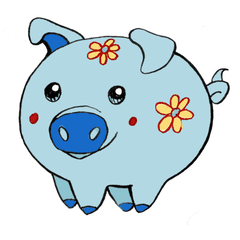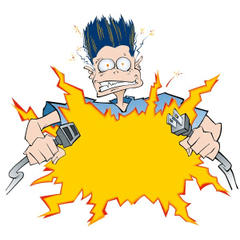Speedpaint - Fantastic scene.
Hi, I'm very happy to be here again.
This time I want to share with you a tutorial summary of the process to make this fantastic scene, with the semi-realistic technique.
Brushes.
I share my set of brushes for free., They can be very useful for this technique.
You can also use your favorite brushes, I recommend you do tests with them, moving the levels of [opacity], [Brush density] and color mixing.
Sketch.
Whether we do everything from our imagination or we have references or even models, it is important to capture our idea with free lines first, it is useful to have more than one version (when time permits) you can vary the colors, the poses the values of light and shadow. This stage will allow us to be sure of our choice as well as we will refine our ability to make great compositions.
Good planning will save a lot of time later.
It is recommended on the same composition to make color tests following the rules of color harmony, you can make a bank of combinations for future compositions.
First strokes
Now we proceed to start our work, I usually start on a canvas not so large to debug the eraser, and I will refine the drawing until it is satisfied, As much of the detail I will do painting, it is not necessary to take great care of the details.
It is very important to review in our drawings: the line of movement, the proportions and the structure, as well as the good interaction of the actors and the correct perspective for both.
Light and shadow values
Once the structure is solid, and our characters have a balance between mobility and weight, and also the background sketch feels well integrated. We proceed to divide the different planes into different gray scales, the fastest way is using the loop tool, the color slider without saturation and the [alt] + [backspace] key combination to fill.
These tools will help us a lot throughout the painting.
We are selecting in a new layer each element of the different planes, and we are filling them each with a different luminous value, (foreground, background, third plane ... and background)
Gradient map as color base
We go to the menu [layer / new correction layer / gradient map] and add this layer to help us set the general shade that our paint shadows will have.
In the gradient bar we choose the darkest and lightest color, then add the intermediate colors and move the sliders until a desired tone is achieved.
These questions can help. What color do I prefer the general environment? What color shadows and lights?
The brushes go into action.
It is time to work the background, we hide a moment the silhouettes of our characters and work in a layer above the silhouettes of the background, we will "stain" in a general way the elements that we want in our landscape, you can use references, from different landscapes that are similar to what you imagine, Important, the rules for these spots is to slightly respect the level of brightness and the tone of each area to be painted. That is, with similar colors.
The characters on stage.
Once the background is outlined, we can start working on our characters, to give it a little more contrast with respect to the background, we can adjust the brightness and color slightly.
Later with a layer on top and linked to the color base we add airbrush shadows or any soft brush.
Canvas size
Now we can give a correct size to our canvas, the recommended for a scene like this is a resolution of 300 (we can also opt for 144 depending on our equipment, I try not to exceed 6000 pixels on either side.
Second layer of stain characters
As the characters will be the most detailed of all the painting these will carry several layers of paint, it is recommended
"Work from the general to the particular"
This is a maxim that also deals with traditional art and helps us maintain a balanced piece that feels like a set.
Later we can combine the layers that are on the base color of each character, starting with the layer closest to the farthest. We get a unique coat of paint for each one.
Moment of painting.
One of the funniest moments arrives, we already have all the bases ready, background and characters, so it is time to paint. We take one of the characters and start adding colors advancing in their details. We are shaping the small elements moving "fast" throughout the figure. Let's not get to the maximum detail yet. Once we have one, we go with the other character.
Supporting information
If at this stage you feel that you could use some training and extra information for this painting technique, I recommend you take a look at my basic painting tutorial in the brushes section. So you can resume your painting with greater security I share the link
The legendary art of forging swords.
For the sword we will create a vector layer and draw a line with a solid edge brush (marker that comes from the factory in CSP)
Then we duplicate this layer.
It is important that they are vector lines because we can have the same line, but a thicker and a thinner line with the thickness correction tools of the tool.
The thickest line is for the handle, the thinnest for the cutting edge, with the lasso tool we select and erase the excess of each one.
when we have the handle and the edge of the desired thickness we can rasterize the layers by right clicking on the area under the name of the layer.
Then with the lasso tool we finish shaping the sword by adding and removing paint to the contour, for this it is important to have a reference at hand. I share with you the silhouette of the painted sword.
Now we can add a layer linked to the base of the sword and we can paint it without problems.
General Detailed
Using this same technique with loop we define the areas to be painted, in this way we correct the contour and add details in specific areas.
In some cases, before the loop we will make a temporary layer to make some sketch or drawing.
A little magic
It is time to get some tricks, with the shortcut "J" we find the tool [color mix] ideal to sweep the color of our paint, with this tool at the same time of the brush that we have occupied we are shaping the spell of our painting.
We complete the trick by adding layers some by copying the same element others by adding some fog or shine with airbrush, and the final touch, we use the blending modes, overexpose color and add brightness to some layers. We also tested with different types of opacity.
In the end we put everything in a folder and to this we apply a layer mask to make transparent or more solid sections of the magic element.
There last cover of painting
After we have worked the whole piece with these techniques, what remains is to give a general review, we start at the bottom.
We add a correction layer with gradient map as it appears in the image, this will make the background turn gray
Then we add another layer in overlay blending mode. and we paint on it, we can do this using the colors we decided at the beginning of our work and a little intuitively to see that it looks good, the idea is to add that magical atmosphere in addition to adding more color contrast between the background and the characters .
To the folder where the new color is and the gradient map we add a layer mask and with the mask we select press the [backspace] key to make it black.
Later, with the airbrush and with the selected mask we are painting and partially making the color visible, in this way we integrate it to the original landscape.
Finishes
The next thing is to add the small elements and take now if the level of detail to the maximum we have decided for this piece.
With the laso tool we can work small objects and add different terrain textures very easily combining this with the normal brush strokes
Completed work
Thank you very much for following this tutorial, I hope it has been useful and soon to read your comments, I leave the final image and of course the speedpainting Greetings, until next time.





















Comment